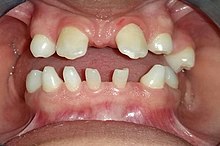Van der Woude sendromu
van der Woude sendromu (Demarquay sendromu), otosomal dominant yolla aktarılan kalıtsal bir sendromdur. Popliteal pterygium sendromu gibi kromozom 1q32 üzerindeki IRF6 geninin mutasyonu sonucu ortaya çıkar; bu nedenle “popliteal pterygium sendromu”nun bulguları daha az olan hafif türü olarak nitelenir.[1][2][3][4]

Kız çocuklarının daha çok etkilendiği görülmektedir. Klinik bulgular, popliteal pterygium sendromu’na kıyasla daha azdır: Yarık dudak, yarık damak ve küçükdil yarığı (uvula bifida); alt dudakta mukus içeren tükürük salgısının geldiği fistüller; eksik dişlerin olması (hipodonti) saptanır.[3][4]
Kaynakça
değiştir- ^ Kondo S, Schutte BC, Richardson RJ, et al. Mutations in IRF6 cause Van der Woude and popliteal pterygium syndromes. Nature Genetics, 32(2):285-289, 2002
- ^ de Lima RL, Hoper SA, Ghassibe M, et al. Prevalence and nonrandom distribution of exonic mutations in interferon regulatory factor 6 in 307 families with Van der Woude syndrome and 37 families with popliteal pterygium syndrome. Genetics in Medicine, 11(4):241–247, 2009
- ^ a b Ferrero GB, Baldassarre G, Panza E, et al. A heritable cause of cleft lip and palate--Van der Woude syndrome caused by a novel IRF6 mutation. Review of the literature and of the differential diagnosis. European Journal of Pediatrics, 169:223–228, 2010
- ^ a b Wong FK, Gustafsson B. Popliteal pterygium syndrome in a Swedish family-clinical findings and genetic analysis with the van der Woude syndrome locus at 1q32-q41. Acta Odontologica Scandinavica, 58:2, 85-88, 2000